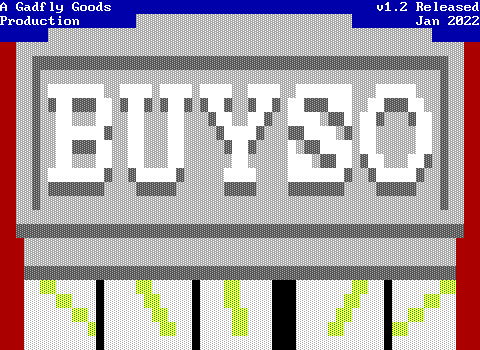
Zephyr's Yuki and the Space Show is a game that dabbles in a little bit of everything. It's the classic triple-threat of action-adventure-puzzle that one might associate with Sweeney's own ZZT worlds. However, this is far from a game of collecting purple keys (though your objective is indeed purple). Yuki goes for something more modern in its design without putting aside a lot of the board design you'd find in early ZZT worlds. As opposed to your typical retro-inspired ZZT worlds (such as Commodore's The Challenge or Bluey's Kobold Smoocher, Yuki brings the past to the present without feeling like it has to ascribe to the conventions of early ZZT worlds. It happily pulls from the positive aspects of these worlds without any need to feel "accurate". In short, it is very much it's own game.

Zephyr pulls you right in from the game's opening, immediately grabbing your attention with what you might think is a barely-animated art board intended to set the scene. A tranquil night with Yuki's cat sleeping atop the cover of a well-made well before revealing the multiple bits of animation as the scene becomes much less still. A big advantage of Zephyr's flatly-colored visual style here is that it allows for a lot more animation to occur in contrast to the more standard STK shading. It's a trade-off that ultimately favors Zephyr, as the loss in detail is outmatched by what can be conveyed when large portions of the board can be manipulated with ZZT-OOP.

This is especially noticed when Zephyr pulls off a creepy appearance of the game's charismatic host and antagonist, Zorblag. This reveal is a borderline jump scare with how effectively it uses ZZT-OOP to show you what was hidden a cycle earlier.
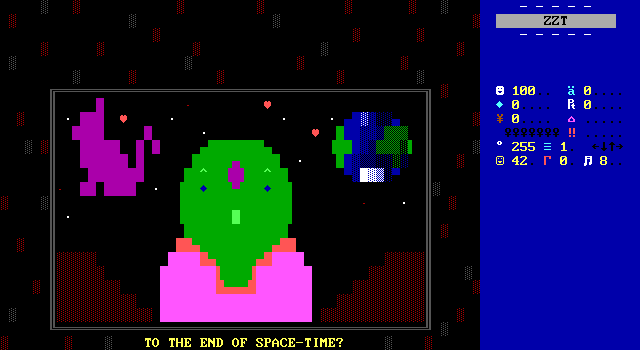
Yuki finds herself and her cat abducted by Zorblag and forced* to participate on an intergalactic television series called "To the End of Space-Time". The rules of the game are simple: Yuki must complete a set of arenas in order to win back her cat and get a return ticket back to Earth. The alternative is to meet a grisly demise that will be broadcast to the masses. The show is part American Gladiators and part The Running Man. The stakes are high, the prizes are low, and it will be no easy task to get through all twelve arenas, a feat that has Zorblag is all too happy to confess that no challenger has ever managed!
The TV theme works beautifully for the game's structure, neatly turning what would be discrete boards with no relation to each other into literal set-pieces. Each arena takes place on a single board, all of which would fit right in as a purple key challenge in a more classically inspired ZZT world. The change in structure from an openly explorable world to a linear set of challenge after challenge makes the game feel fast-paced. As soon as one challenge is conquered Yuki is promptly directed to the next. No doubt the viewers love the endless excitement even if poor Yuki rarely gets a moment to breathe.
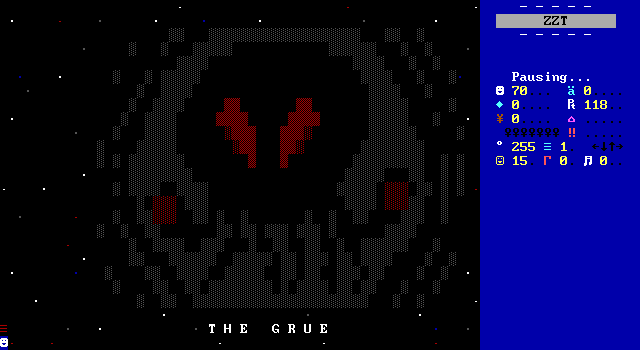
Before actually entering an arena Zorblag gets the crowd hyped up for each event, announcing each arena in a sensational manner. This is done across two map boards which contain simple representations of each arena. It's a cute touch and wholly appropriate for a TV show to document the progress of its current contestant. In addition, when Yuki's next obstacle is a fight against an enemy they receive some amazingly representational artwork. This isn't the typical ZZT design where character art doesn't relate to their ASCII character. Instead Zephyr takes an unprecedented level of care in ensuring that the artwork is a lavish interpretation of an ASCII character. This is impressive to begin with before even considering the difficultly in making a quotation mark appear creepy!
The idea that everything Yuki is doing is all just part of a show works not just for the game's structure, but its gameplay benefits as well. Yuki's health and ammo are all managed by arena wardens. In the fiction of the game, arena wardens have complete control of the environment Yuki is currently in and may manipulate these values at-will. In practice this means Yuki's health can be reset between levels, or purposely put her one injury away from death. Ammo comes and goes as needed as well, sometimes the amounts are generous while other times Yuki will be forced into fights entirely unarmed. The wardens' control is of course Zephyr's control. Again the break from the non-linear structure more common in early ZZT worlds gives Zephyr the opportunity to fine-tune each challenge. By not having to worry about when the player will reach an obstacle he's much more free to adjust the difficulty to exactly the spot he wants. Yuki's arenas could easily been made non-linear and chosen from a Mega Man-esque stage select screen, and while health and ammo could certainly be recalculated between stages, the fixed order also allows each challenge the opportunity to be tougher than the last.
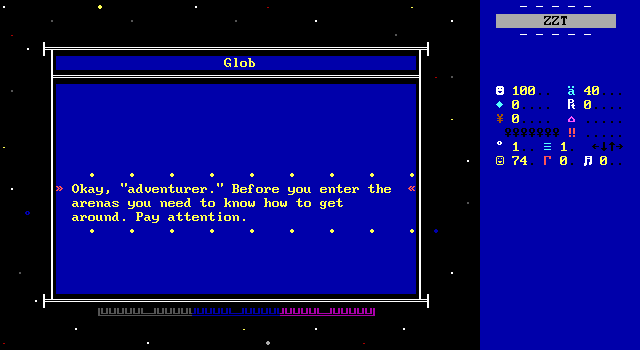
Of course, Yuki isn't just shoved into an arena with a gun (if that) and told "Good luck". While the game has plenty of puzzles for Yuki to figure out, Zephyr does start things off with a behind the scenes training arena. While Yuki has plenty of ZZT's default elements used as minor obstacles as well as the expected ammo, bombs, and energizers it also introduces its own set of elements made from objects that the player absolutely needs to understand if they're going to survive. To teach Yuki the essentials, a stagehand named Glob guides her through a series of small rooms to demonstrate not just the individual components she'll run across, but how to properly apply them.
It's well worth paying attention to, as forgetting what certain symbols mean later on can really slow the game down if you're not capable of interacting with objects properly. There are of course the basic levers you'll find in dozens of worlds which can do anything from open doors to reverse conveyors. You'll often find them near "portals" which will dispense something when activated by a lever. I can't even say "items" over "something" as in some cases one switch may provide ammo just as well as it will provide some enemies to shoot. In addition to the touch activated levers are shot activated targets that function just the same. The most unique and complex device for Yuki to operate is the "bullet transformer" which when touched will #change bullets into something else. These components and the way they interact give Yuki its own style, moving beyond homages to the early 90s, enhancing ZZT in simple ways that can be combined to great effect.
Upon finishing the tutorial, Yuki given one last piece of advice from Glob which sums up the game's tone perfectly:
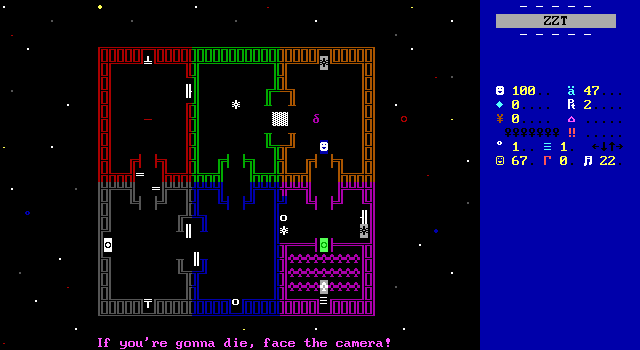
Now Yuki is truly ready.
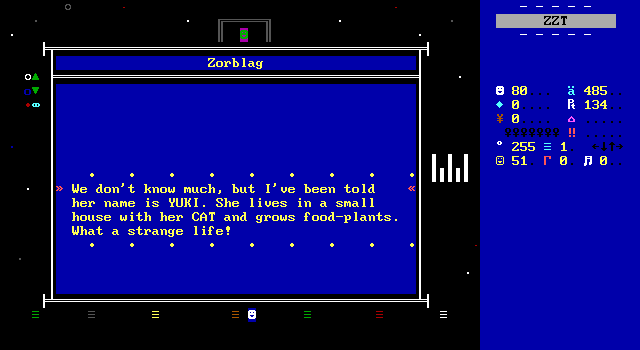
Speaking of Yuki, there isn't a whole lot to the character. Zorblag's own research here is about as much as you get. She loves her cat and hates injustice. Yuki is a borderline silent protagonist, forced to participate in something she has no interest in. She's a bit of a Chell. Throughout the entire live broadcast she'll be completely silent, not even an ellipses to her name. The game's ending fleshes her out a bit more with a bit of insight into how she feels after surviving the show. A few secrets throughout the game can lead to her having something to say at the end which is at least a little bit more than the Portal protagonist. Prior to the show beginning she does have to "volunteer" to be a participant. This dialog is player controlled and deliberately a generic response so it doesn't really give you any insight into her thoughts. Especially since passing up the offer may result in "greatly reduced physical comfort". Needless to say, any waivers are promptly signed before she's ready to begin her arena conquest.
Ironically, despite the tutorial and despite the linear structure to the arenas giving Zephyr such a high level of control over the experience, the first arena, "Portals and Switches" is (for me at least) the least fun to actually play! It's slow and disorienting, a combination of two aspects that clash quite a bit with the rest of the game. The good news of course is that these are hardly insurmountable obstacles. You'll get through the arena eventually, it just sets a harsher vibe that may make someone taking a cursory glance at the game more open to moving on to something else.
This opening arena has a series of small rooms with board edges in the center. Yuki must use these to warp around the board, sometimes wrapping around with the actual edges in order to defeat foes in each chamber. Except there aren't any foes to start. First Yuki must navigate to the series of colored switches, throw one, then race to the correct room and defeat the enemies there while on a time limit to do so! Using fakes that look like solid walls and the general weirdness of hitting board edge tiles in the middle of the room make it take a bit to get the hang of. If you're not stopping to plan your route the timer is short enough that you'll fail and the enemies will turn back into boulders or sliders. Fortunately, as long as you get some enemies before the time expires you'll have fewer to deal with the next attempt allowing for slow, if steady, progress.
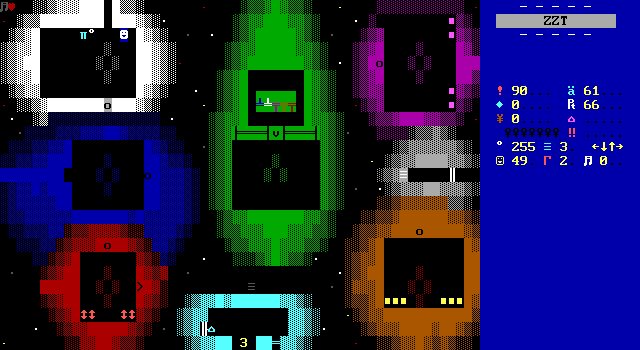
The actual timers aren't too tight, with those for rooms that take longer to reach having a larger timer. Where things get annoying is that getting hit will return you back to the starting point, meaning any damage taken will probably mean having to restart the timer. You can't do this manually either, or start a second timer while the first is running. This means time spent waiting doing nothing for the counter to expire. Even when you do successfully complete a room, there's still the downtime of unraveling a path back to the switch hub to activate the next one.
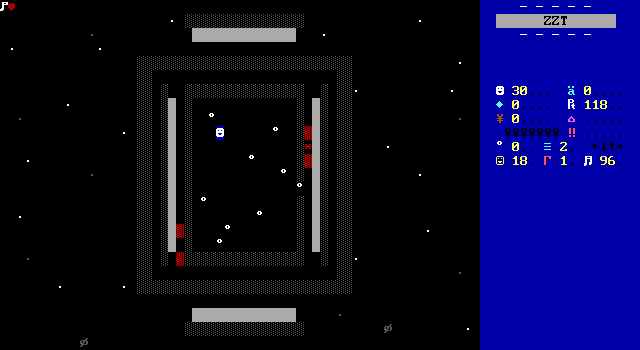
Don't let that false step at the start sour the experience though! Things quickly rebound. Pun not intended actually. The second arena is the first boss battle of the game, fight between Yuki and "THE GRUE", a monster shrouded in darkness that she has to fight without a weapon of her own. For this challenge the player has to focus more on playing defense as the monster orbit the arena, taking shots when Yuki is aligned. Of course, the walls being made of ricochets mean that just because a shot missed the first time around doesn't mean it won't get her on the rebound.
If you've ever played The Mercenary, this is a similar fight to its magma lake boss, but much faster. Zorblag decrees that the fight will end after three hits on either opponent which certainly keeps Yuki moving as there's little room for error. Luckily the grue is a little bit slower so the arena won't fill up with bullets too quickly.

What makes a fun little fight so much more impactful is the background music looped throughout the fight. I've yet to mention it, but Zephyr does some impressive work with the #play format that accompanies some arenas. A surprisingly jaunty battle theme actually fits the scene perfectly, as the two fighters dance across the floor dodging bullets until somebody stops moving. This is a game that really is elevated by its music and sound, an aspect of ZZT worlds that while frequently beneficial, is still rarely intertwined with the game. Zorblag's speeches are often amped up with sound effects that make his dialog something you get to really "hear", bringing intonation to normally pure-text. The sound combining with the text is something I'd love for other ZZT games to learn from as Yuki doesn't have a whole lot of characters that do speak, but the effect shows a ton of promise in giving characters personality and making their dialog more impactful.
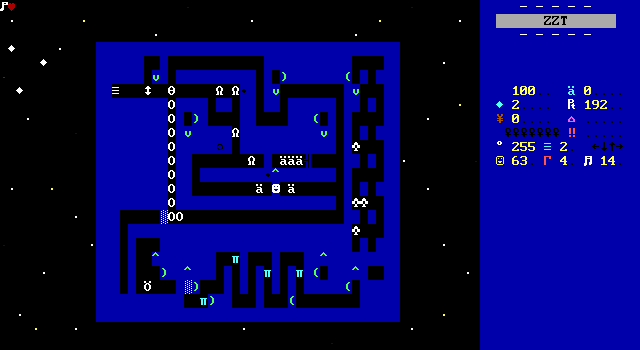
For players that really scan each board, you may find yourself noticing a few oddities here and there, and if you can find ways to access these points, there's a bonus fight and alternate ending if you can find a set of secret keys hidden backstage in some arenas. This leads to a rather challenging boss, which I admit I only reached on my original playthrough of the game. I believe this updated release tones the fight down a little, but be prepared just in case. If you can't reach all of the secrets, that's as good as reaching none. The game itself provides no real hints other than in how certain boards look. Of course, so much as looking at the board titles in the editor or Museum File Viewer is enough to part the curtain a little. It's very much possible to play through the entire game without finding a single one of these hidden areas. However, the ending makes it clear in more ways than one that there's something else to work towards beyond just becoming the first winner of "To The End of Space-Time".
Without going beat by beat, Zephyr's arenas offer a wide variety of activities for the player to participate in, never truly repeating itself. The puzzle arenas are fairly straightforward involving figuring out how to use boulders and sliders to get at other portions of boards, but aren't anything remotely full of gridlock that you'd think of if they were described as slider puzzles. One is a more open-ended take on City's Spa. This actually is one of the more frustrating puzzles not because of its difficulty to figure out, but rather because it requires precise timing and any mistake means having to nearly start over. It's nothing that some liberal saving can't get around, though it is a part of the game that slows things down once again like its first arena.
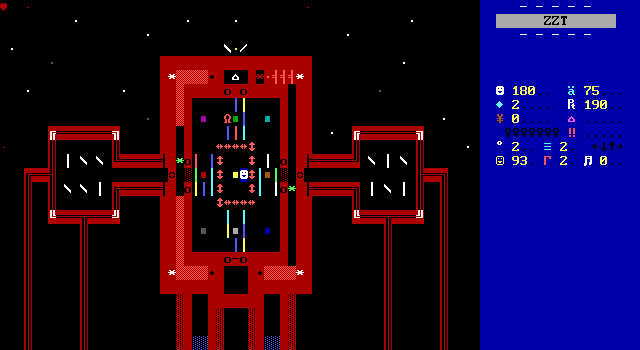
The most impressive arena is probably "The Engine", a board which takes place a dangerous power station. This one pulls off some impressive coding to divide the play area into a 3x3 grid where one cell will surround itself with sliders, safely containing Yuki inside. It's up to her to figure out the rules for which cell is the safe cell, as lingering outside results in a devastating barrage of stars. Expect a few reloads during this one as the penalty for a mistake is pretty significant and it will undoubtedly take a few tries before you piece things together.
One thing to note is that while Yuki seems to stick to simple concepts and provides a helpful tutorial for its own elements, it can require some knowledge that I think is a bit esoteric for a complete newcomer to ZZT. There are plenty of beginner friendly worlds that have been created in recent years, but I can't advise this to anybody without some experience under their belt. The use of board edges without explanation, needing to know the nuances of how ZZT's pausing works, and a solid understanding of how ricochets function all add up to make this one where a new player can easily get stuck. The comprehension of ricochets comes easily enough after playing the original worlds, but the first two can be pretty jarring and unintuitive for a beginner. You can of course refer to the old livestream of the game to see how everything is solved, but overall this is a game that should land better for those who are active in the ZZT community today or were active in its past.
These potential issues haven't gone completely unnoticed by Zephyr, and an Itch page exists for a 1.5 release with some early dev logs, though it's "Early 2021" release date and lack of updates mean for the time being the current release on the Museum is all that's available. (It even mentions moving the current first arena to later in the game.) I'd still very much like to see this updated release since otherwise this would be an excellent sampling of the kind of what can be done with ZZT both in presentation and content.
I hope I'm not coming off as harsh towards this game. If I didn't think this was something great I wouldn't be giving it the featured status.. Yuki and the Space Show is definitely a modern classic. Everywhere you look you're going to find evidence of the special care Zephyr gave Yuki. The musical themes, the variety of puzzles, the clever boss fights, it all adds up to a great experience. It just has a few peculiarities at points that can slow down the pace of the game and potentially really stump newer players.

On the more action-oriented side of things, Zephyr does a solid job making these literal arenas respectably distance themselves from the bland generic boss fights that plague many a ZZT world. Each of the three main boss fights does something different to keep the player from just pumping bullets into aliens. The Grue was discussed earlier with it's decision to prevent Yuki from attacking directly. Other fights will allow her to shoot, though being able to actually land a hit requires moving quickly and knowing when to actually take a shot. The third boss pits Yuki against a teleporting foe that requires some effort in order to deal with the boss's minions and still have time to go on the offense. Fighting them feels like one of the better bosses in Tseng's Gem Hunter trilogy.
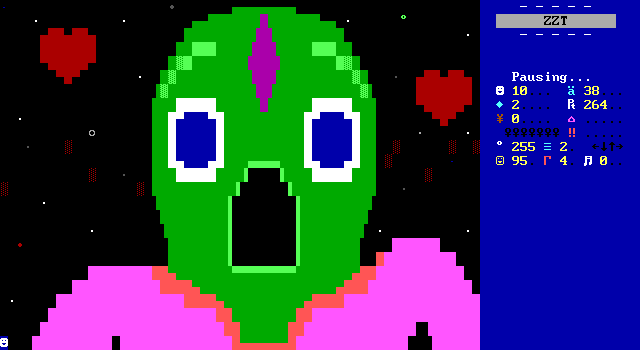
If you're able to get past a slow start and aren't the type to be caught off guard in terms of how ZZT's core gameplay functions, Yuki and the Space Show is a really well-rounded game. There's really something in it for everybody with it's unique foes, clever puzzles, and great presentation. It's a treat to look at and listen to, and I still find myself humming the first boss theme days after replaying it. The deadly TV show theme is well-integrated into the game's design, making the prime-time televised blood-sport an integral part of the game that unifies the entire experience. The writing is pretty straightforward, with Zorblag doing most of the talking which makes him as memorable a villain as Richard Dawson. Yuki feels like a one-man followup to Best of ZZT, but forges an identity of its own rather than just connecting the boards in whatever way makes them fit. If you haven't tried this one out yourself, it's definitely a great game to play from start to finish, or take a commercial break after an arena or two.

